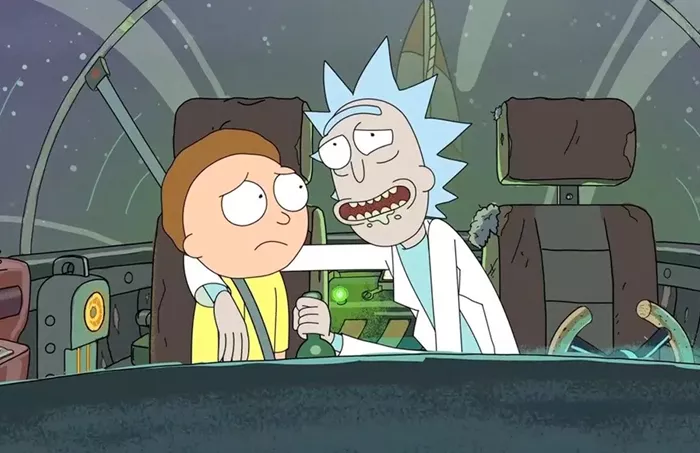The animated series “Rick and Morty” has captured the imaginations of audiences worldwide with its dark humor, complex characters, and intricate plotlines. One of the most shocking moments in the show occurs when Rick, the brilliant but often morally ambiguous scientist, punches his grandson Morty. This incident has sparked numerous debates among fans and critics alike, questioning the motivations and implications behind this act. In this article, we will explore the context, character dynamics, and underlying themes that may explain why Rick punched Morty.
Context of the Punch
The Episode in Question
The punch occurs in the episode “The Vat of Acid Episode,” which is the eighth episode of the fourth season. This episode is particularly notable for its exploration of Rick and Morty’s relationship and the consequences of their actions. The central plot revolves around Rick creating a device for Morty that allows him to reset his life to a previous save point, much like a video game. This device leads to a series of increasingly absurd and dark scenarios, culminating in the punch.
The Build-Up
Throughout the episode, Morty uses the device to indulge in various experiences, often disregarding the moral and ethical consequences. Rick observes these actions with increasing frustration. Morty’s reckless behavior and lack of consideration for the consequences of his actions serve as a catalyst for Rick’s eventual outburst.
Character Dynamics
Rick’s Perspective
Rick Sanchez is a character known for his genius intellect, nihilistic worldview, and complex emotional landscape. Despite his often callous behavior, Rick harbors deep, albeit conflicted, feelings for his family, particularly for Morty. Rick’s frustration with Morty in this episode stems from his perception of Morty’s immaturity and lack of responsibility. Rick’s punch can be seen as an expression of his exasperation and a twisted form of tough love.
Morty’s Perspective
Morty Smith is a teenager who is frequently caught in the whirlwind of Rick’s adventures. His relationship with Rick is complicated, characterized by both admiration and resentment. In “The Vat of Acid Episode,” Morty’s actions demonstrate a desire for independence and agency, but they also reveal his naivety and shortsightedness. Morty’s misuse of the device and the resulting chaos highlight his struggles with understanding the broader implications of his actions.
See Also: Is There a Bug’s Life 2?
Themes Explored
Consequences and Accountability
One of the central themes of “The Vat of Acid Episode” is the concept of consequences and accountability. Throughout the series, Rick often manipulates time, space, and reality with little regard for the repercussions. In this episode, Morty is given a taste of this power, and his actions lead to disastrous results. The punch can be interpreted as Rick’s harsh way of teaching Morty about the weight of responsibility and the importance of considering the impact of one’s actions.
Power Dynamics
The power dynamics between Rick and Morty are also a significant factor in the punch. Rick’s superior intellect and technological prowess often place him in a position of authority over Morty. However, Morty’s use of the device challenges this dynamic, creating tension between the characters. The punch serves as a physical manifestation of this struggle for control and dominance.
Emotional Catharsis
Rick’s punch can also be seen as an emotional release. Throughout the series, Rick is portrayed as a deeply troubled individual, grappling with feelings of loneliness, regret, and self-loathing. His relationship with Morty is one of the few meaningful connections he has, and Morty’s actions in this episode push Rick to his breaking point. The punch is an outburst of the pent-up emotions Rick has been harboring, revealing the complexity of his character.
Analyzing the Punch
Symbolism and Metaphor
The punch is not just a physical act but also a symbolic one. It represents the culmination of the tension between Rick and Morty, as well as the broader themes of the series. The punch can be seen as a metaphor for the harsh realities of life and the painful lessons that come with growth and understanding. It serves as a stark reminder of the consequences of recklessness and the importance of accountability.
Fan Interpretations
The punch has been the subject of much debate among fans, with various interpretations emerging. Some view it as a necessary wake-up call for Morty, a moment of tough love that ultimately strengthens their relationship. Others see it as an indication of Rick’s abusive tendencies and the toxic nature of their dynamic. These differing perspectives highlight the complexity of the show and the multifaceted nature of its characters.
The Aftermath
Impact on Rick and Morty’s Relationship
The punch has a profound impact on Rick and Morty’s relationship. It forces both characters to confront the underlying issues that have been simmering beneath the surface. For Rick, it is a moment of self-reflection and acknowledgment of his own flaws. For Morty, it is a wake-up call that forces him to grapple with the consequences of his actions and the reality of his relationship with Rick.
Long-Term Implications
In the broader context of the series, the punch serves as a turning point. It marks a moment of growth and development for both characters, setting the stage for future episodes. The incident also adds depth to the show’s exploration of complex themes, such as the nature of power, responsibility, and the human condition.
Conclusion
The moment when Rick punches Morty in “The Vat of Acid Episode” is a pivotal one in the series “Rick and Morty.” It is a complex and multifaceted act that can be interpreted in various ways, reflecting the intricate character dynamics and thematic richness of the show. The punch serves as a catalyst for growth and understanding, forcing both Rick and Morty to confront their flaws and the consequences of their actions. Ultimately, it is a testament to the depth and complexity of “Rick and Morty,” a show that continues to challenge and captivate its audience with its dark humor and profound insights.

